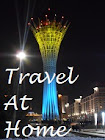The thing is she just didn’t get it. I couldn’t make her understand. My highly sensitive child won’t perform for just anyone. He needs to feel safe. He only lets his emotions go in a trusted environment, with people who love him unconditionally. His lunchtime meltdowns are reserved for me. Not for his teacher, not in her classroom, nor in our home.
Three hours at a time with thirty other children has its toll on my highly sensitive son. Let’s be honest, for many people some kind of minor breakdown would be on the cards after a day with thirty children. For a child with heightened senses a busy classroom is a minefield.
We use the metaphor of a bucket; every direct interaction my son has, every indirect interaction he witnesses, goes into his bucket. Every sight, sound, smell and action gets thrown in there unfiltered. With a classroom teeming with small children his bucket fills quickly. In no time it overflows.
 |
| Photo Credit: KD Kelly |
I put my arms around him and I feel the energy raging within his little body, stress with nowhere to go. Words stumble over each other to get out of his mouth, trying to sum up the whirlwind that has been his morning, trying to empty his overladen bucket.
We walk home. Either there are tears as we walk, or the beginnings of a meltdown. Or silence. But no matter how the short walk home has been I know that when I open the front door to our home, once he crosses that threshold to safety, he will fling the bucket he has spent the morning filling across our hallway.
He will scream, cry, lash out, fight my every move; nothing will be right. His jacket refuses to hang on his hook. He can’t get his shoelaces undone. His sandwich filling is wrong. The bread is cut wrong. His brother is making too much noise. His plate is the wrong colour.
For eighteen long, emotional, stressful months we search for solutions. We talk to his teachers. I share that he is highly sensitive. I share that he needs time out, he needs quiet time, a place to reset, to empty his bucket out before it fills to the top. But I face a brick wall.
His teachers say he doesn’t want quiet moments, doesn’t need time alone. They tell me he’s a good learner, that he’s their idea of a perfect child in the classroom: he listens; he follows instructions; he doesn’t make a fuss. They tell me he’s enjoying himself. They tell me he’s never had a tantrum in school, never kicked a chair in his classroom, never shouted at them or a classmate. They tell me they see no problem in school, it has nothing to do with them; it’s a problem our family needs to solve at home. We need to leave the scientifically unproven idea of highly sensitive children at home, and let him get on with it at school, where he’s the perfect student.
They refuse to scratch beyond the surface, to see beyond the façade. They don’t see me dragging a screaming, crying little boy over the threshold of safety back into the world every day after lunch. They don’t see me coaxing a five-year-old boy out of the house for an afternoon at school. They don’t see the bruises on my shins from the kicks I get as I try to get shoes back on my distraught child to leave the house. They don’t see my tears, the conflict raging inside me. I want to keep him home but I can’t, not every day. They refuse to see the conflict raging inside my son.
By the time the battle is over and he’s back in school both our tears have faded, his anger has subsided.
I tell his teacher it has been a struggle to get him back there. I can see her rolling her eyes. Not literally of course, but I know she’d like to. And I walk back home, knowing I’ll do it all again in two hours because his bucket will fill unhindered during the afternoon.
He will come home overwhelmed because the new girl has been crying on her first day, because his friend fell over and hurt his arm, because the last piece of the puzzle he was doing did an impromptu vanishing trick, because the noise levels in class reached a new high, because he couldn’t get the teacher’s attention for help, because he hated the drawing he made.
He’ll come home overwhelmed because he’s highly sensitive and he doesn’t yet have the tools to filter out the things he doesn’t need to keep in his bucket. He needs help with it all. He needs support. He needs a reminder to seek out a quiet space. But for some reason I can’t get that for him in his classroom, where he spends most of his day.
Instead I get the offer of a lunch date at our house. Failing that maybe I could videotape one of his meltdowns for them. Because seeing is believing, right? Perhaps it would be better to accept the word of a mother, a mother at her wit’s end trying to help her son, a mother whose heart breaks every time she picks her son up from school because she sees his soul being destroyed little by little in a classroom that is a long way from being suitable for a highly sensitive child.
He’s in a different school now, one that understands that all children are individuals. That the boy at home and the boy in school is part of the same whole. His teacher understands that he needs time, space and quiet to empty his bucket. She believes without seeing. She supports him, without needing to see him at his worst. Sometimes seeing is believing, but other times it needs to be a matter of trust.
 |
| Photo Credit: Karolina Michalak |
*Please note that as of 1 November 2014 I have launched a new blog called Happy Sensitive Kids, for parents of highly sensitive children, or for those parenting children as highly sensitive people. Please visit Happy Sensitive Kids for more information sources and the blog - http://happysensitivekids.wordpress.com. You can also keep up to date on the accompanying Facebook page of the same name.*

































